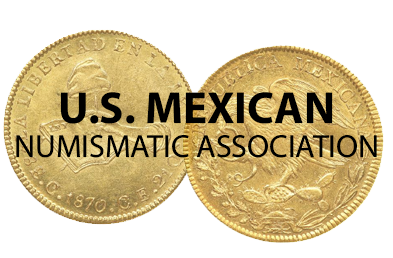Five centavos coins (1905-1976)
The 5-centavos coins were made in seven basic types.
Type 1 – Nickel
Type 2 – Monogram
Type 3 – Aztec Calendar
Type 4 – Josefa Grande
Type 5 – White Josefa
Type 6 – Brass
Type 7 - Brass, reduced
Type 1 – Nickel
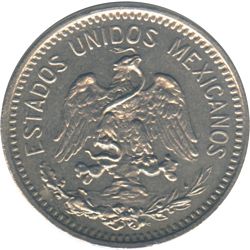
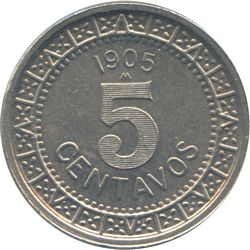
KM-421 1905 5c
These were authorised by the decrees of 25 March and 5 April 1905. These nickel coins have a diameter of 20 mm and a weight of 5 g.
In some years the metal, blanks or even the minting was provided by foreign mints in Europe, since Mexico did not stand out for being a producer of pure nickel.
| Year | Mintage | |
| 1905 | 1,420,000 | |
| 1906 | 10,614,000 | includes small mintmark, large mintmark, 6 over 5 |
| 1907 | 4,000,000 | |
| 1909 | 2,051,600 | |
| 1910 | 6,181,200 | |
| 1911 | 4,486,925 | includes narrow date and wide date |
| 1912 | 420,000 | includes small mintmark and large mintmark |
| 1913 | 2,035,000 | includes narrow date and wide date, 13 over 12 overdate |
| 1914 | 2,000,000 | includes narrow date and wide date |
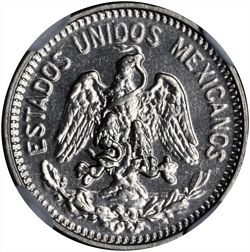
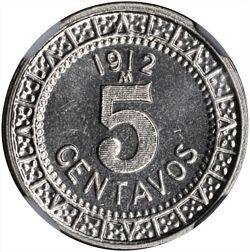
KM-421 1912 5c large mintmark (Stack’s-Bowers ANA auction, 4 August 2017, lot 21268)
From 1907 to 1910 all the coins were minted by the English mint of Birmingham, while most, but not all, 1906 and 1911 coins came from there.
In 1910 and 1911 the blanks were manufactured by Scovill in Waterbury, Connecticut and Coe Brass in Torrington, Connecticut, each shipping 200,000 blanks annually. In 1911 and 1912 the blanks were made by the Arthur Krupp factory in Berndorf, Austria.
For a detailed study of the M mintmark and other varieties of this series, see Scott Doll's article here.
Type 2 – Monogram
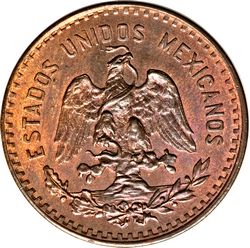
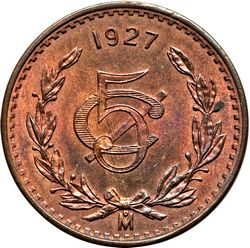
KM-422 1927 5c
Because of the cost of metals and difficulties in importing due to World War I, in 1914 the nickel coins were replaced by larger ones in the Monogram series in bronze, similar to the circulating 1c and 2c coins. These had a diameter of 28 mm and weight of 9 g.
| Year | Mintage | |
| 1914 | 2,500,000 | |
| 1915 | 11,423,940 | |
| 1916 | 2,860,000 | |
| 1917 | 800,000 | |
| 1918 | 1,332,000 | |
| 1919 | 400,000 | |
| 1920 | 5,920,000 | |
| 1921 | 2,080,000 | |
| 1924 | 780,000 | |
| 1925 | 4,040,000 | |
| 1926 | 3,160,000 | |
| 1927 | 3,600,000 | |
| 1928 | 1,740,000 | small date, large date |
| 1929 | 2,400,000 | |
| 1930 | 2,600,000 | round 0, square 0 |
| 1931 | mintage unknown. About 250 coins released into circulation | |
| 1933 | 8,000,000 | |
| 1934 | 10,000,000 | |
| 1935 | 21,980,000 |
Pablo Luna Herrara reports 1928 coins with a small and large date. “The small date is due to a modification of the die used in the punches of a 2-centavo coin, which due to its smaller size has a smaller date and when minted with the modified die on the planchet of a 5-centavos coin the date looks different. The large date on the 1928 coin is from the normal die without modification.
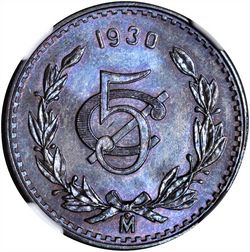
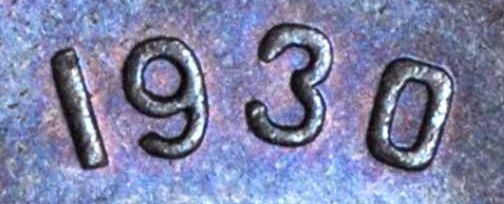
KM-422 1930 5c small square 0 in date (Stack’s-Bowers ANA auction, 4 August 2017, lot 21271)
Another variety is in the 1930 coin with square and round zeroes. This is also due to a modification of the die.
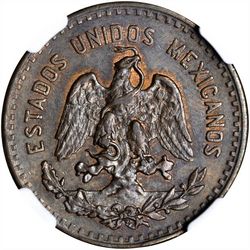
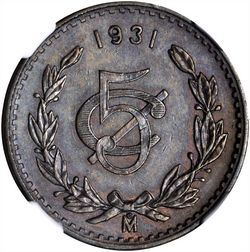
KM-422 1931 5c (Stack’s-Bowers ANA auction, 4 August 2017, lot 21272)
On the 1931 issue William Laurence Hanks wrote “it was not discovered until the late 50s and early 60s, in 1963 Neil Utberg reported only three pieces existed, however, the author points out that from his experience he has seen 40 to 75 genuine pieces, but of those only one in BU. Stack’s-Bowers, in 2017, added "Mintage unknown. Dies were produced for this issue and samples were struck to test each pair of dies, however the Banco de Mexico did not order any 5- centavo coins to be produced for this year. It is estimated that about 250 pieces were struck to test the dies and these were later released into circulation rather than being melted."
Type 3 – Aztec Calendar
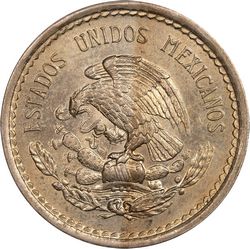
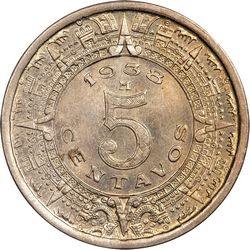
KM-423 1938 5c
In 1936 a new 5-centavo coin, authorised by Lázaro Cárdenas in a decree of 26 March 1936(footnote}Diario Oficial, Tomo XCVI, Núm. 3, 6 May 1936, in cupronickel was introduced, weighing 4 grams and 20.5mm in diameter. These coins, engraved by Manuel Luna Negrete, had a border on the reverse depicting the ancient Aztec Calendar Stone.
| Year | Mintage | |
| 1936 | 46,700,000 | |
| 1937 | 49,0860,000 | |
| 1938 | 33,400,000 | |
| 1940 | 22,800,000 | |
| 1942 | 7,100,000 |
The minting of these coins was suspended on 29 December 1942Diario Oficial, 31 December 1942 due to the increase in the price of the metal in World War II. They were demoneterised on 31 December 1943.
Type 4 – Josefa Grande
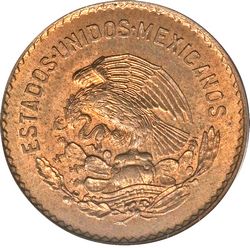
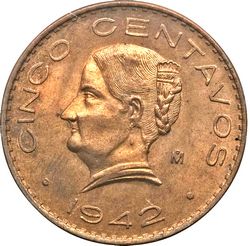
KM-424 1942 5c
This series has a weight of 6.5 g, diameter of 25.5 mm and was composed of 95% copper, 4% zinc and 1% tin.
The decre authorising the issue was promulgated on 28 December 1942 but minting began on 19 December, so the coins was produced for less then 30 days.
| Year | Mintage | |
| 1942 | 900,000 | low mintage |
| 1943 | 54,660,000 | |
| 1944 | 53,463,120 | |
| 1945 | 44,262,000 | |
| 1946 | 49,054,000 | |
| 1951 | 50,758,000 | |
| 1952 | 17,674,000 | |
| 1953 | 31,568,000 | |
| 1954 | 56,680,000 | |
| 1955 | 21,114,000 |
Type 5 – White Josefa
On 29 December 1949, after the devaluation of the peso, Miguel Aleman issued a decree changing the designs of the denominations up to and including the $1 valueDiario Oficial de la Federación, 30 December 1949.
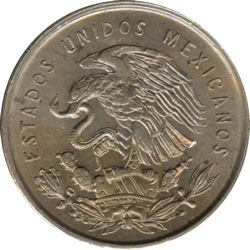
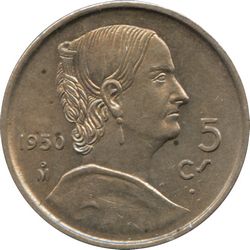
KM-425 1950 5c
These were authorised as the government needed a coin that was cheaper to produce. These had a different bust of Josefa Ortiz de Domínguez. They had more nickel in their composition (75% copper, 25% nickel) and so had a whitish appearance. Weight was 4 g and diameter 20.5 mm. Mintage was 5,700,000 in 1950.
It is believed that it went out of circulation as it was easily confused with the 25-centavo coin in circulation.
Type 6 – Brass
The devaluation of the peso in 1954 wreaked havoc on the national currency. On 13 September 1955 Adolfo Ruiz Cortines issued a decree giving the specification of a new issue of new coinageDiario Oficial, 15 September 1955.
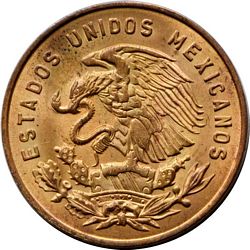
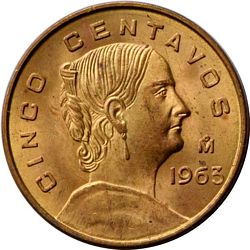
KM-426 1963 5c
The 5-centavo coin was reduced in size and weight compared with Type 4. Like Type 5 these had a weight of 4 g and diameter of 20.5 mm but were in brass (85% copper, 15% zinc).
As stated, these were authorised by a decree of 13 September 1955, so the Mint anticipated the publication of the decree with coins dated 1954.
| Year | Mintage | |
| 1954 | dot, no dot | |
| 1955 | 12,136,000 | |
| 1956 | 60,216,000 | |
| 1957 | 58,288,000 | |
| 1958 | 104,624,000 | |
| 1959 | 106,000,000 | |
| 1960 | 99,144,000 | |
| 1961 | 61,136,000 | |
| 1962 | 47,232,000 | |
| 1963 | 136,680,000 | |
| 1964 | 71,168,000 | |
| 1965 | 155,720,000 | |
| 1966 | 124,944,000 | |
| 1967 | 118,819,000 | |
| 1968 | 189,588,000 | |
| 1969 | 210,492,000 |
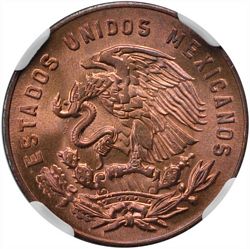
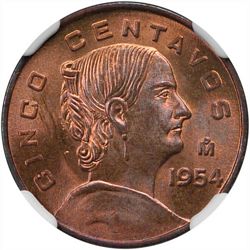
KM-426 with dot behind portrait (Stack’s-Bowers ANA auction, 7 August 2017, lot 22967)
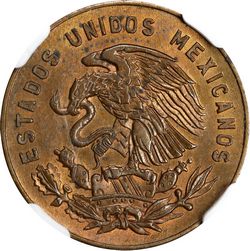
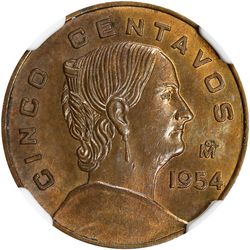
KM-426 without dot behind portrait (Stack’s-Bowers auction, 28 February 2023, lot 72246)
Type 7 - Brass, reduced
On 27 December 1969 Gustavo Díaz Ordaz authorised a new series of coinage from the one centavo to the twenty-five pesoDiario Oficial, 30 December 1969.
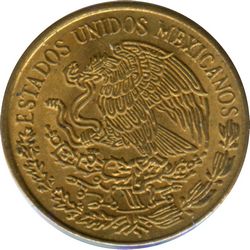
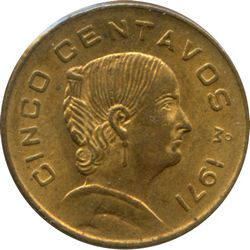
KM-427 1971 5c
The 5c coin was re-designed with a new eagle on the obverse, being 2.55 mm smaller in diameter (18 mm) and with a lower copper content. Mintage was
| Year | Mintage | |
| 1970 | 163,368,000 | |
| 1971 | 198,844,000 | |
| 1972 | 225,000,000 | |
| 1973 | 596,070,000 | |
| 1974 | 401,584,000 | |
| 1975 | 342,308,000 | |
| 1976 | 367,524,000 |
In 1976, due to the strong devaluation of that year, the Treasury authority concluded that a 5-centavo coin did not represent a considerable purchasing value, so its manufacture would not continue. It took 16 years for the return of this denomination, motivated by the Monetary Reform of 1992, which removed three zeros from the peso.
